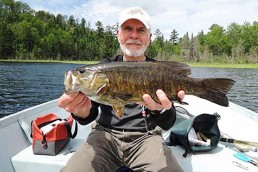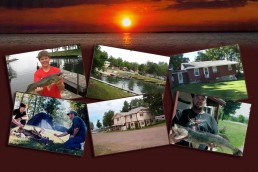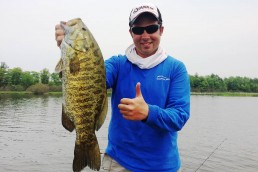Mining Smallmouth Gold on Chequamegon Bay
A fine mist filtered down and a thin fog rolled in from Lake Superior. Doug turned his boat away from the landing to head across the bay to a long thin, windswept point where we expected to find Chequamegon Bay’s famed smallmouth bass. Winds were light, only ruffling the surface, which is unusual. Normally the water is a lot rougher.
We glided across the bay and pulled up to the inside of the point. We flipped stick baits into shallow water. We continued for about 20 minutes when a brown shape swirled at my bait next to the boat. A few casts later I felt a fish slam my bait. My casting rod was bent in half as the fish raced off, rod tip plunging.
In the shallow water the fish didn’t have many places to go, so it vaulted out of the water, landing with a splash and pulled away. Smallies are known for never giving up, and this fish was no exception. It made a couple more runs by the time I got it back to the boat.
Doug stood nearby with the net. The fish kept pulling away even when I had it next to the boat, and finally I was able to lead it into the net.
The fish was a 17-inch smallmouth bass, thick with muscle.
“That’s what I’m talking about,” Doug said as we exchanged high-fives.
Ten minutes later Doug yelled he had a fish on and I could hear the fish splashing as it launched itself out of the water. Doug’s fish was no different than mine. It never gave up. It made several short runs that Doug stopped, and even when we got the fish turned around it still raced off again.
It was my turn to man the net. Once again this fish never gave up, even as it thrashed and twisted in the mesh of the net. Doug’s fish was about the same size as mine.
“It’s a little pig,” Doug remarked as he slipped the fish back in the water.
Doug Hurd, of Eagan, Minn., and I were fishing Chequamegon Bay in early June. We came for smallmouth and we were finding them.
If you are looking to catch a trophy smallmouth, perhaps one of the best places anywhere in the Midwest is Chequamegon Bay, right off Lake Superior in northern Wisconsin.
Chequamegon Bay is approximately 12 miles long and eight miles wide at its widest point. That is a lot of water holding a lot of big smallmouth bass. Ashland, Wisconsin sits on the southeastern edge of the bay and is ground zero for the best smallmouth fishing in the Midwest.
Ashland is a good starting point for great fishing. There are numerous motels and restaurants available for visiting fishermen. There are also several bait shops in town with all the latest information on where to find fish and what baits are currently working. Also there are several landings nearby for access to the bay.
Doug and I have been fishing Chequamegon Bay for several years. During early season from mid-May through mid-June the smallmouths are usually in relatively shallow water. We have caught huge smallies in just a foot or two of water this time of the year.
For early-season fishing we have found that three basic baits work well. Stickbaits and jerkbaits used in shallow water are deadly on early-season smallmouths. Some of our favorites have been Husky Jerks by Rapala and the Rogue by Smithwick. Gold seems to be an especially productive color. Topwater baits also work well in early season. The ones that seemed to work the best for us were the thinner profile baits such as the Devil’s Horse by Smithwick.
Our most productive bait has been plastics. Doug and I are particularly partial to sinking worms. Although we sometimes fish them wacky style with the hook in the middle, we have found fishing them Texas-rigged has been the most successful. There are a lot of submerged logs washed up in the shallows, so using the Texas rig, with the hook buried in the body of the worm, prevents a lot of hook-ups with sunken timber.
Color seems to make a difference at times. Anything in green or pumpkinseed works well. If the fish are finicky, and they can be that way in the early season when haunting shallow water, it pays to experiment. In those situations we have caught smallies with lime-colored worms laminated with white or yellow. Also darker green with bright red sparkles has worked well.
It was now late afternoon and Doug and I moved to the other side of the point. The area was sandy with scores of old logs, some possibly a hundred years old, washed up into the shallow water after they broke off log rafts being dragged down the lake. We switched to plastic worms.
Doug was fighting a smallmouth and it raced off, vaulting out of the water and then diving. Doug stopped the fish but only for a moment and it took off again.
I stood by with the net and eventually Doug brought the fish to the boat but it kept pulling way. It darted off three or four times before I could scoop the net under it. It was a 19-inch fish.
A few minutes later I felt weight on my line and I pulled back to set the hook. My spinning rod came alive as it is pumped from a smallmouth racing off. I turned the fish and once again as in typical smallmouth fashion, the fish didn’t give up. It made a couple of runs, pulled the line off the drag and Doug waited with the net while I fought the fish in. When I measured the fish it stretched out to 18 inches.
“This is what we came for,” I told Doug as I released the fish. By the end of the day as we headed back to the landing, Doug and I estimated we caught about 30 smallmouth bass. The smallest was 14 inches and the largest was about 20 inches long. Once again, Chequamegon Bay lived up to its reputation of having some of the best smallmouth fishing
MWO
SHARE THIS POST
Did you enjoy this post?
You can be among the first to get the latest info on where to go, what to use and how to use it!
Mike Yurk
Mike Yurk grew up in Oshkosh, Wis., where he first started writing about the outdoors. A retired Army officer, he is now a full-time, freelance outdoor writer. He has written more than 1000 articles for outdoor publications and published 12 books on outdoor sports. He lives in northwestern Wisconsin where he has found some of the best bass fishing in the country.



